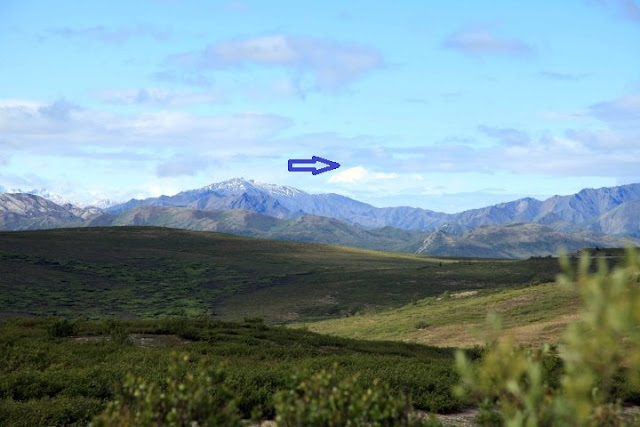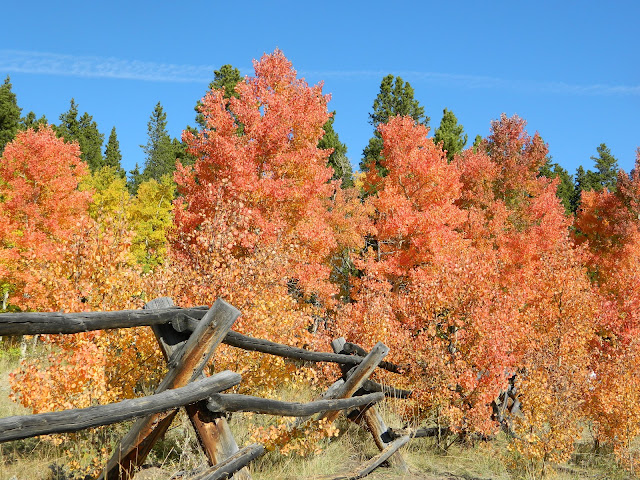I love all kinds of excitement and flying around the summit of Mt. McKinley in Alaska was an amazing adventure that was beyond my wildest imagination. The views from the small plane window were heavenly.
With the first snow fall here in the Denver area this week, it made me yearn for another look at the magnificent snow covered mountain that I was privileged to view up close.
Mount McKinley has the bragging right of being the highest point in North America. It has a summit elevation of 20,320 feet or 6194 meters, above sea level. Measured from base to peak, it is also the world's tallest mountain on land.
The day before my plane excursion I had been on a tour of Denali National Park. The scenery was exquisite and my first sight of Mt. McKinley was when it revealed itself in the distant mountain range. At first I thought it was a cloud but when I realized it was the famed Mt. McKinley I was thrilled. So often the mountain stays hidden from anxious viewers. Below the arrow points to the snow capped mountain in the background. When I saw this I had no idea that the next day I'd be circling it in a small aircraft.
Because of weather conditions the original reservation for another excursion was cancelled. Weather in the area is like that. To my delight this flight to the Summit was still taking off and there was room for my daughter and I. Our adventure of an up close look at Mt. McKinley began at the Talkeetna air strip where we climbed into a twin engine, oxygen equipped aircraft.
Inside the plane we put on our ear phones and checked where our oxygen lines were.
The aircraft was not insulated so we felt the air getting thinner as we gained altitude. We put on our winter coats as the air got chillier and our pilot gave us the word when to put on our oxygen masks, although I think we all were aware "it was time." Wearing our oxygen masks was definitely a photo opportunity.
Mt. McKinley, known locally as Denali, meaning "The Great One" in the Athabaskan language, stands as a challenge to high altitude climbers who seek to reach the summit. In the lodge where we stayed there was a board reporting how many climbers were currently on the mountain. As we flew around the summit we could see the base camp and the pin points of individual climbers on their route. Below you can see an aerial view of the paths of the climbers as they make their way to the summit. Climbers take two to four weeks to scale the mountain.
The pin dots you see in the center of the picture below is another view of the base camp for the climbers. On average there are 1,275 climbers each year. 51% of them reach the summit.
Permanent snowfields cover over half the mountain. Five giant glaciers, icefalls, spurs and buttresses add to the huge snowy mass seen in these pictures.
A panoramic view of the mountain range as we approached the summit.
Soaring high around the summit I used my camera to take a bird's eye view of our flight
The summit...20,320 feet right outside my window.
The views were constantly changing as we surveyed the area.
In the 1890's the mountain was named after President William McKinley by a gold prospector in political support of the president from Ohio. The Alaska Board of Geographic Names later changed the mountain's name to Denali. In 1975 the Alaska State Legislature attempted to get the name officially documented but it was blocked by members of the Ohio congressional delegation. Therefore, Denali is the correct name according to the Alaska state board while Mt McKinley is the correct name according to the National Board of Geographic Names. This explains my comment earlier as to why Denali is the local name.
The mountain is recognized as the "coldest" mountain in the world. Temperatures are recorded at an automated weather station at 18,700 feet. The lowest temperature recorded is a minus 100 degrees Fahrenheit (-73 degrees Celsius) with a North American record windchill of a minus 118 degrees Fahrenheit (-83.4 degrees Celsius). The freezing temperatures are cold enough to flash freeze a human. I don't know what the outside temperatures were when I was there but I do know inside the plane is was so cold that my camera on my phone froze and never worked again.
Seeing this great mountain in all it's splendor was an amazing travel experience that I dearly loved.
“Once you have tasted flight, you will forever walk the earth with your eyes turned skyward, for there you have been, and there you will always long to return.”
― Leonardo da Vinci
― Leonardo da Vinci


































.jpg)




























